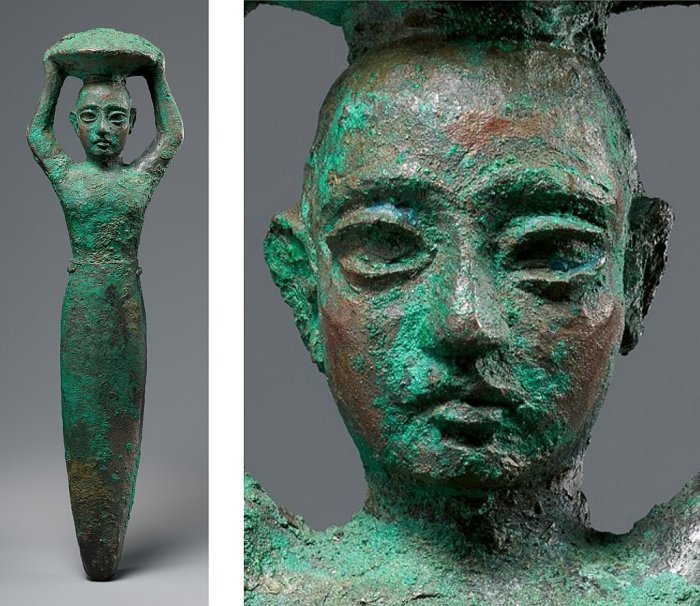Aluminum Was Used At Least 7,000 Years Ago – Long Before The Metal’s Official Invention In 1825
Ellen Lloyd - AncientPages.com - Today, Danish physicist Hans Christian Oersted is credited with aluminum's invention. In 1825, Oersted successfully separated aluminum metal from its oxide and techniques to produce aluminum in 1889.
What is not well-known is that Oersted was by no means the first person who invented aluminum.
Foundation figure of king Shulgi of Ur, carrying a basket. Metalwork-Sculpture. Image credit: Metropolitan Museum of Art - CC0
People in Mesopotamia were familiar with aluminum thousands of years ago. Aluminum was used at least 7,000 years ago, and our modern discovery of this valuable metal is nothing but a re-invention based on the knowledge our ancestors already possessed.
While excavating in Iraq, archaeologists discovered pottery produced around 5,300B.CC. These artifacts were made of clay that contained aluminum.
There is also archaeological evidence Egyptians and Babylonians used aluminum compounds in various medicines and chemicals almost 4,000 years ago.
In his writings, Pliny the Elder A.D.D 23 – 79.), a Roman scholar described an element he called alumen. It's today known as alum, a compound of aluminum widely used in the ancient and medieval world to fix dyes in textiles.
In 1959, Chinese archaeologists discovered intriguing belt buckles. Scientists wondered how our ancestors could produce these artifacts that offered evidence of advanced knowledge in metallurgy.
Ancient Chinese belt buckles revealed traces of aluminum.
In 1961, French scientists examined these belt buckles and concluded that the ancient Chinese were making aluminum through an unknown process.
We should not forget a fascinating aspect. Aluminum is the most abundant metal on the planet but requires electricity to create metal in a usable form. If our ancestors could produce aluminum they must have been familiar with electricity.
On the other hand, if that is the case, it isn't a surprise because we have seen on several occasions that our ancestors were much more advanced than previously thought.
Ancient civilizations mastered astronomy, metallurgy, medicine, engineering, and other science areas. Unfortunately, our modern world cannot take credit for many "new discoveries". Most of our so-called inventions are nothing but re-inventions.
It's possible knowledge of aluminum goes much further back in time than we can imagine. In 1974, a strange object was brought to light by a group of construction workers digging in the area of central Romania.
This mysterious object was approximately 1mm thick and covered with a layer of aluminum oxide. It's considered to be millennia old….
Written by Ellen Lloyd – AncientPages.com
Copyright © AncientPages.com & Ellen Lloyd All rights reserved. This material may not be published, broadcast, rewritten or redistributed in whole or part without the express written permission of AncientPages.com and Ellen Lloyd.
More From Ancient Pages
-
 On This Day In History: William Laud Archbishop Of Canterbury Beheaded – On Jan 10, 1645
News | Jan 10, 2017
On This Day In History: William Laud Archbishop Of Canterbury Beheaded – On Jan 10, 1645
News | Jan 10, 2017 -
 Pharaoh Psusennes I Buried In The Silver Coffin Inlaid With Gold
Civilizations | Jul 16, 2016
Pharaoh Psusennes I Buried In The Silver Coffin Inlaid With Gold
Civilizations | Jul 16, 2016 -
 The Controversial History Of Moses – Who Was He Really?
Biblical Mysteries | Sep 13, 2015
The Controversial History Of Moses – Who Was He Really?
Biblical Mysteries | Sep 13, 2015 -
 3.2 Million-Year-Old ‘Lucy’ Could Walk On Two Legs – First Hominin Muscle Reconstruction
Archaeology | Jun 20, 2023
3.2 Million-Year-Old ‘Lucy’ Could Walk On Two Legs – First Hominin Muscle Reconstruction
Archaeology | Jun 20, 2023 -
 On This Day In History: ‘Battle On The Ice’ – Army Of Prince Nevsky Against Teutonic Knights Was Fought – On Apr 5, 1242
News | Apr 5, 2016
On This Day In History: ‘Battle On The Ice’ – Army Of Prince Nevsky Against Teutonic Knights Was Fought – On Apr 5, 1242
News | Apr 5, 2016 -
 Mysterious Medieval Cemetery In Wales With People Buried In Unusual Positions Puzzles Archaeologists
Archaeology | Jan 3, 2024
Mysterious Medieval Cemetery In Wales With People Buried In Unusual Positions Puzzles Archaeologists
Archaeology | Jan 3, 2024 -
 On This Day In History: Sack Of Rome Took Place on May 6, 1527
News | May 6, 2016
On This Day In History: Sack Of Rome Took Place on May 6, 1527
News | May 6, 2016 -
 Never-Before-Seen Object Found In The Skull Of Powerful Ancient Ruler Raises Many Questions
Featured Stories | Nov 12, 2024
Never-Before-Seen Object Found In The Skull Of Powerful Ancient Ruler Raises Many Questions
Featured Stories | Nov 12, 2024 -
 Prehistoric House Of The Dead Discovered In Wiltshire – Is This The Burial Place Of Ancestors Of Stonehenge Builders?
Archaeology | Jul 17, 2017
Prehistoric House Of The Dead Discovered In Wiltshire – Is This The Burial Place Of Ancestors Of Stonehenge Builders?
Archaeology | Jul 17, 2017 -
 Mythical Danaides: Daughters Of Danaus Condemned In Hades To Eternal Punishment
Featured Stories | Mar 22, 2016
Mythical Danaides: Daughters Of Danaus Condemned In Hades To Eternal Punishment
Featured Stories | Mar 22, 2016 -
 Was Megalithic Stone Circle Of Mzoura The Tomb Of Giant Antaeus?
Civilizations | Sep 5, 2015
Was Megalithic Stone Circle Of Mzoura The Tomb Of Giant Antaeus?
Civilizations | Sep 5, 2015 -
 Controversial Discovery Of 5,7-Million-Year-Old Footprints On Crete Could Re-Write History Of Human Evolution
Archaeology | Sep 5, 2017
Controversial Discovery Of 5,7-Million-Year-Old Footprints On Crete Could Re-Write History Of Human Evolution
Archaeology | Sep 5, 2017 -
 Has World’s Oldest Image Of Virgin Mary Been Discovered In Dura-Europos Church?
Archaeology | Mar 17, 2017
Has World’s Oldest Image Of Virgin Mary Been Discovered In Dura-Europos Church?
Archaeology | Mar 17, 2017 -
 LIDAR Discovers Lost Colonial City Hidden In The Amazon Rainforest
Archaeology | Oct 22, 2024
LIDAR Discovers Lost Colonial City Hidden In The Amazon Rainforest
Archaeology | Oct 22, 2024 -
 Only Apocalyptic Destruction Can Eliminate The Gap Between Rich And Poor – Historian Says
Featured Stories | Jun 6, 2018
Only Apocalyptic Destruction Can Eliminate The Gap Between Rich And Poor – Historian Says
Featured Stories | Jun 6, 2018 -
 13,000-Year-Old Eye Needles Made By Early North Americans Discovered
Archaeology | Dec 2, 2024
13,000-Year-Old Eye Needles Made By Early North Americans Discovered
Archaeology | Dec 2, 2024 -
 Lake Titicaca Reveals More Ancient Underwater Secrets
Archaeology | Oct 11, 2013
Lake Titicaca Reveals More Ancient Underwater Secrets
Archaeology | Oct 11, 2013 -
 Viking Burial Rituals: High Ancient Funeral Pyre Reflected High Social Status
Ancient Traditions And Customs | Mar 13, 2017
Viking Burial Rituals: High Ancient Funeral Pyre Reflected High Social Status
Ancient Traditions And Customs | Mar 13, 2017 -
 Mabon Festival And The Autumn Equinox Celebrated By Pagans
Ancient Traditions And Customs | Sep 19, 2024
Mabon Festival And The Autumn Equinox Celebrated By Pagans
Ancient Traditions And Customs | Sep 19, 2024 -
 Great Lady Of Champagne – Barbe-Nicole Clicquot Ponsardin: Widow, Mother, Skilled Businesswoman
Featured Stories | Aug 22, 2019
Great Lady Of Champagne – Barbe-Nicole Clicquot Ponsardin: Widow, Mother, Skilled Businesswoman
Featured Stories | Aug 22, 2019



